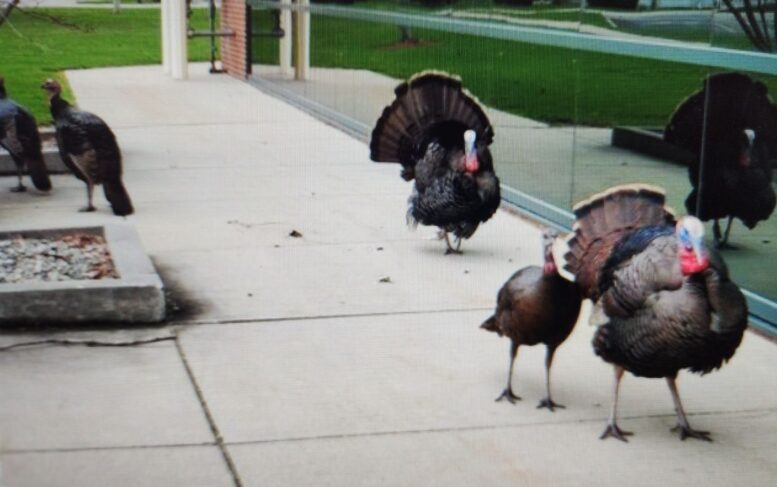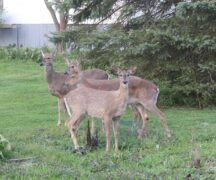By JAN McLAUGHLIN
BG Independent News
For years the wild turkeys slowly strutting through Bowling Green neighborhoods have captivated residents. But in recent months, some small groups of the turkeys have turned hawkish – attacking mail carriers, blocking streets and frightening people as they enter the hospital.
Bowling Green residents have long coexisted with urban wildlife, like the feathered flocks. But the once passive birds have become brazen – and wildlife experts are saying that humans have created the problem.
Because of complaints about the big birds chasing people, city officials and postal officials have been working with the Ohio Department of Natural Resources to solve the problem of aggressive turkeys. ODNR officials have walked the mail routes where the turkeys have been harassing carriers.
Unlike Canada geese that are known for having real attitudes, turkeys are typically shy and avoid humans. But it appears these flocks have been egged on by residents who feed them, said City Communications Director Amanda Gamby.
Though there are multiple groups of turkeys which have made Bowling Green home, the most aggressive gang hangs out in the area of Wood County Hospital, in the 900 block of West Wooster Street.
“We’ve got a number of people who are feeding them,” Gamby said. “The more comfortable they get, the more they associate humans with a food source. So stop feeding them.”
When roaming around neighborhoods in a group, turkeys can be intimidating. The males can weigh up to 25 pounds, have a wingspan of 5 feet and reach 4 feet tall. The turkeys have reportedly been tracking a couple mail carriers in that area of the city.
Beth Trudeau, who lives in the 800 block of West Wooster Street, said she witnessed one of the attacks, in which the mail carrier climbed up on a stone wall to get away from the birds.
“I’d never seen anything like it in my life,” she said. “These turkeys are really aggressive.”
Trudeau said her husband ran outside and yelled at the birds to distract them, and a motorist driving by stopped to let the carrier in his pickup truck. Another neighbor reported the turkeys pecked a hole in the carrier’s clothing.
“It was horrifying to watch,” Trudeau said. “Thank God the truck stopped. It was the scariest thing I’ve ever seen.” The mail carrier now uses an umbrella to discourage the turkeys, Trudeau said.
The turkeys have also become unwanted guests outside the Wood County Hospital. Once a topic of curious conversation, they have crossed the line to becoming worrisome.
“They have been a very big problem for us,” said Cristy Walton, of the hospital foundation.
The turkeys tend to hang out by the front doors of the hospital, leaving messes and sometimes intimidating patients so much that they go to the ER entrance.
“They come right up to you and start squawking,” Walton said. “We don’t want patients to feel compromised.”
She understands that some people enjoy seeing the turkeys, but “if you’re living with it day to day,” it’s far from ideal, Walton said. “It would be really nice if they were relocated.”
A nearby neighbor on Haskins Road said he has had encounters with the wild turkeys, but none so problematic. Rob Harms told of pulling into his back drive and stopping for an obstinate turkey that was standing its ground.
“We stared at each other for quite a while,” he said. The standoff ended when the turkey seemed to get bored and strutted off, Harms said.
These types of interactions aren’t normal for wild turkeys. But they are examples of what happens when a turkey doesn’t have to work for its food. Being fed by humans emboldens the birds to antagonize people who aren’t feeding them.
“They are not pets,” said Kristin Otley, director of Bowling Green’s Park and Recreation Department. “The biggest thing is – don’t feed them. We know people are.”
Cinda Stutzman, the city’s natural resources manager, knows the turkeys can be threatening.
“When they puff out their feathers, they look very big,” she said.
But part of Stutzman’s role is to educate local residents to coexist with wildlife.
“It’s my job to teach everyone to live with urban wildlife,” she said. “I know there are issues and people are upset. I’m sure it’s not fun to be the postal worker on that route.”
Bowling Green residents should learn how to discourage turkeys from getting too close – by being loud, clapping hands, making yourself appear big, squirting them with a water bottle or hose, or using an umbrella.
It wasn’t that long ago, when residents enjoyed having the big birds stroll through their neighborhoods, Stutzman reminded.
“People love the turkeys. People love watching them. They are here to stay,” Stutzman said. “We are going to have to learn to live with them.”
And that means local residents need to stop feeding the birds, and stop filling bird feeders unless they are 4.5 feet off the ground – where their long necks can’t reach. People needn’t worry – the turkeys will find their own food, Stutzman assured.
And residents should start harassing the turkeys who get too comfortable and territorial in yards, Gamby said.
“Don’t try to take selfies with the birds. Don’t try to pet the turkeys,” she said.
City officials want postal carriers to perform their duties without fear of being pecked.
“They have become very familiar with their routes,” Gamby said of the turkeys tracking the deliveries.
And city leaders are aware of the feathered flock outside the hospital.
“There is a gang that hangs out by the hospital,” she said.
The main trouble makers are two or three males, who are especially aggressive.
“For this particular flock, it may be too late,” to retrain them to be timid around humans, Gamby said. City officials have talked with ODNR about trapping and relocating the problem turkeys in a more rural area.
“It’s very difficult to capture turkeys in an urban environment,” Gamby said. But talks with ODNR will continue.
“We’re speaking with them regularly,” she said.
If you are having problems with wild turkeys, some items to remember:
- Shiny objects and windows attract turkeys.
- Make loud noises to scare them away.
- Always remain cautious when driving.
- Roosting turkeys in your yard may become territorial.
- Try to keep bird feeding areas clean or avoid using them.
For years, wild turkeys – the largest game bird in the U.S. – were scarce after being over-hunted in Ohio. Then hunting regulations were implemented that allowed turkeys to once again thrive. And the fact that corn fields border Bowling Green may make the city appealing to turkeys.
Here’s some other turkey trivia from the Michigan Department of Natural Resources:
- Wild turkeys usually get around by walking or running, but they can fly, and they typically roost overnight in tall trees.
- Wild turkeys can reach speeds of up to 55 mph.
- Turkeys can have a wingspan of 4 to 5 feet, and may reach 4 feet tall. Males can weigh up to 25 pounds.
- A group of turkeys is called a “rafter.”
- Flocks can range anywhere from five to 50 birds.
- Generally, only male turkeys puff out their feathers and fan their tails to attract females.
- Male turkeys have spurs on their legs that get longer as they age. Spurs are used to grapple with other turkeys over breeding rights.
- Breeding begins as temperatures rise and daylight hours increase in spring. Males attract females by strutting, gobbling and fanning their tails.
- Wild turkeys establish a pecking order; one turkey in each male flock becomes dominant. Male turkeys may become aggressive. They may attack their reflections.
- It is important to establish your dominance; if turkeys become habituated, they may act aggressively. Use gentle hazing techniques to deter them. Start by making loud noises and waving to frighten the turkeys. Consider using a sprinkling system or spraying water from a hose to harass them. Leashed dogs can also be used to scare them away.


